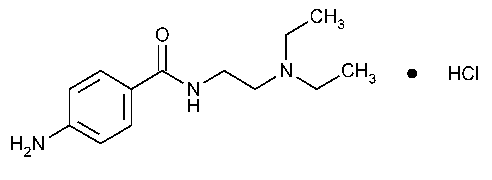Procainamide Hydrochloride
Benzamide,4-amino-N-[2-(diethylamino)ethyl]-,monohydrochloride.
p-Amino-N-[2-(diethylamino)ethyl]benzamide monohydrochloride [614-39-1].
»Procainamide Hydrochloride contains not less than 98.0percent and not more than 102.0percent of C13H21N3O·HCl,calculated on the dried basis.
Packaging and storage—
Preserve in tight containers.Store at 25 ,excursions permitted between 15
,excursions permitted between 15 and 30
and 30 .
.
Identification—
A:Infrared Absorption á197Kñ.
B:Standard solution—
Use the Standard solutioncontaining 0.2mg of USP Procainamide Hydrochloride RSper mL,prepared as directed under Ordinary impurities.
Test solution—
Dilute the Test solution,prepared as directed under Ordinary impurities,with methanol to obtain a solution containing about 0.2mg of procainamide hydrochloride per mL.
Adsorbent,Eluant,and Visualization—
Prepare as directed in Ordinary impurities.
Procedure—
Proceed as directed for Procedureunder Ordinary impurities á466ñ:the RFvalue of the principal spot obtained from the Test solutioncorresponds to that obtained from the Standard solution.
Loss on drying á731ñ—
Dry it at 105 for 4hours:it loses not more than 0.3%of its weight.
for 4hours:it loses not more than 0.3%of its weight.
Residue on ignition á281ñ:
not more than 0.1%.
Heavy metals,Method IIá231ñ:
0.002%.
Ordinary impurities á466ñ—
Test solution:
methanol.
Standard solution:
methanol.
Adsorbent:
chromatographic silica gel.
Eluant:
a mixture of chloroform,methanol,and ammonium hydroxide (70:30:0.7).
Visualization:
1,followed by spraying with a 1in 2000solution of fluorescamine in acetone and viewing with UVlight at 366nm.
Organic volatile impurities,Method Iá467ñ:
meets the requirements.
Limit of free p-aminobenzoic acid—
Mobile phase andResolution solution—
Proceed as directed in the Assay.
Standard solution—
Quantitatively dissolve an accurately weighed quantity of USP Aminobenzoic Acid RSin Mobile phaseto obtain a solution having a known concentration of about 0.25µg per mL.
Test solution—
Transfer 25.0mLof the stock solution used to prepare the Assay preparationto a 50-mLvolumetric flask,dilute with Mobile phaseto volume,and mix.This solution contains about 0.25mg of procainamide hydrochloride per mL.
Chromatographic system—
Proceed as directed for Chromatographic systemin the Assay.In addition,the tailing factor for the p-aminobenzoic acid peak in the chromatogram obtained from the Resolution solutionis not more than 2.0;and the relative standard deviation for replicate injections of the Standard solutionis not more than 3.0%.
Procedure—
Separately inject equal volumes (about 20µL)of the Standard solutionand the Test solutioninto the chromatograph,record the chromatograms,and measure the responses for the p-aminobenzoic acid peaks.Calculate the percentage of p-aminobenzoic acid in the portion of Procainamide Hydrochloride taken by the formula:
20(C/W)(rU/rS),
in which Cis the concentration,in µg per mL,of USP Aminobenzoic Acid RSin the Standard solution;Wis the weight,in mg,of Procainamide Hydrochloride taken to prepare the stock solution for the Assay preparation;and rUand rSare the p-aminobenzoic acid peak responses obtained from the Test solutionand the Standard solution,respectively.The limit is 0.1%.
Assay—
Mobile phase—
Prepare a suitable mixture of water,methanol,and triethylamine (140:60:1);adjust with phosphoric acid to a pHof 7.5±0.1;filter;and degas.Make adjustments if necessary (see System Suitabilityunder Chromatography á621ñ).
Standard preparation—
Quantitatively dissolve an accurately weighed quantity of USP Procainamide Hydrochloride RSin Mobile phaseto obtain a solution having a known concentration of about 0.5mg per mL.Quantitatively dilute an accurately measured volume of this stock solution with Mobile phaseto obtain a Standard preparationhaving a known concentration of about 0.05mg per mL.
Resolution solution—
Dissolve a quantity of p-aminobenzoic acid in Mobile phaseto obtain a solution containing about 0.1mg per mL.Pipet 10mLof this solution and 10mLof the stock solution used to prepare the Standard preparationto a 100-mLvolumetric flask,dilute with Mobile phaseto volume,and mix.
Assay preparation—
Transfer about 50mg of Procainamide Hydrochloride,accurately weighed,to a 100-mLvolumetric flask;dissolve in and dilute with Mobile phaseto volume and mix.Transfer 10.0mLof this stock solution to a second 100-mLvolumetric flask,dilute with Mobile phaseto volume,and mix.
Chromatographic system(see Chromatography á621ñ)—
The liquid chromatograph is equipped with a 280-nm detector and a 3.9-mm ×30-cm column that contains 10-µm packing L1.The flow rate is about 1mLper minute.Chromatograph the Resolution solution,and record the peak responses as directed for Procedure:the resolution,R,between the p-aminobenzoic acid and procainamide peaks is not less than 5.0.The relative retention times are about 0.5for p-aminobenzoic acid and 1.0for procainamide hydrochloride.Chromatograph the Standard preparation,and record the peak responses as directed for Procedure:the relative standard deviation for replicate injections is not more than 2.0%.
Procedure—
Separately inject equal volumes (about 20µL)of the Standard preparationand the Assay preparationinto the chromatograph,record the chromatograms,and measure the responses for the major peaks.Calculate the quantity,in mg,of C13H21N3O·HCl in the portion of Procainamide Hydrochloride taken by the formula:
1000C(rU/rS),
in which Cis the concentration,in mg per mL,of USP Procainamide Hydrochloride RSin the Standard preparation;and rUand rSare the peak responses obtained from the Assay preparationand the Standard preparation,respectively.
Auxiliary Information—
Staff Liaison:Andrzej Wilk,Ph.D.,Senior Scientific Associate
Expert Committee:(PA5)Pharmaceutical Analysis 5
USP28–NF23Page 1624
Pharmacopeial Forum:Volume No.29(5)Page 1565
Phone Number:1-301-816-8305
